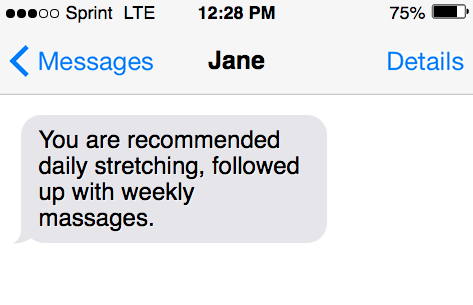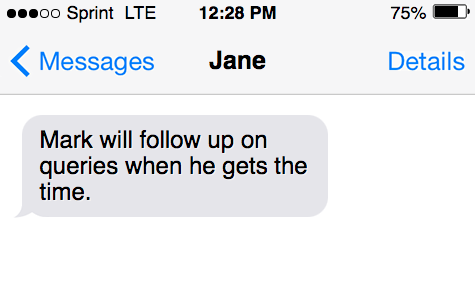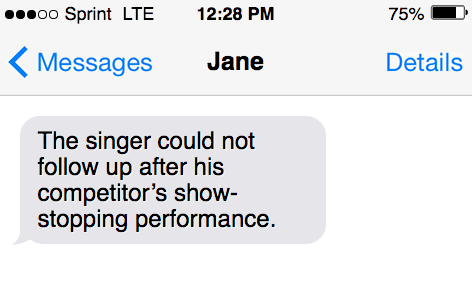Is it followup or follow up? What if I want to follow up on an email? How do I spell that correctly? The English language has its fair share of misspellings. Is it “absence” or “absense”? Only one of them is correct.
The terms “follow up” and “followup” create a similar issue. However, both words are correct. They are simply two different parts of speech. “Follow up” is a verb while “followup” can be an adjective or a noun.

What does it mean to “follow up”
When you use “follow up” in written or spoken communication, you are asking someone to do something. Or, you are describing an action someone else took. In this sense, the term acts like a verb.
“Follow up” means investigating further, pursuing a clearly defined end. Sentence – “Please follow up with the client tonight,” “You can learn a lot if you follow up on the news every day” – both ask someone to check on a task.
By adding prepositions “with” or “on” you can change the meaning of “follow up” in a sentence.
Learn the difference in this video
How is “following up” used in American English
The suffix “-ing” turns “follow up” into a progressive verb. “Following up” could mean many things:
- Doing something on top of which has already been done – “Her morning routine starts at 5, following up with a 10 mile run”.
- Checking for updates – “Keep following up on Christie for availability”.
- Pursue an outcome or solution – “Detectives continue following up the case”.

When to use “follow up”
Use “follow up” when you want to ask or request someone to do something. This could mean pursuing a target in order to reach a solution or doing another task after completing one.
- “Parents have to follow up with the school to check if their child got admission.”
- “Fitness enthusiasts are advised to follow up exercise with good nutrition.”
When you say “follow up with” there is a direct object involved. The term is a transitive verb.
In the first sentence, parents want to find out if their child made it into the school. The second sentence means fitness enthusiasts should eat good food in addition to exercising.
However, when you say “follow up on” there is no clearly defined object. In this context, the preposition “on” indicates a pursuit. This makes “follow up” an intransitive verb.
- “Follow up on James.”
- “He will follow up on the suggestion.”
Both these sentences show action. But there is no clearly define object. In the first sentence, someone must speak to James for an update. What is the update? The sentence does not define it.
The second sentence does not specify what the suggestions are. It implies that someone will look them up.

Sentence examples
Here are some examples of “follow up” in a sentence:
- It is hard to follow up with dating after a disappointing first meeting.
- You are recommended daily stretching, followed up with weekly massages.
- Mark will follow up on queries when he gets the time.
- The singer could not follow up after his competitor’s show-stopping performance.
- Swift rain quickly followed up with a thundering storm.
- Dedicated cold calling requires a salesperson to follow up every lead.
- Doctors follow up past history of patients they see regularly.
- Follow up the current mail; do not start a new email thread.
- The defendant is prepping to follow up the new evidence in the trial.
- Please follow up on our restaurant reservations at 6.
- To follow up without being annoying, call or text people regularly – not frequently.
Hope the above examples helped you in understanding how to use “follow up” in daily written and verbal communication.

When to use “followup”
In contrast to “follow up”, which is a verb, “followup” can be either a noun or adjective. Most people write “followup” with a hyphen “-“ in between. The popular variation then becomes “follow-up”, although the meaning remains the same.
For instance, a potential candidate may follow up with their hiring employer regarding a job. The candidate may also suggest setting up a “followup” meeting with the employer to clear things out.
“Followup” means a pursuit to find a solution or a check for updates. It could also means something which happens after the completion of something else, like a followup checkup after treatment.
Similarly, in the event of sending out a followup mail, “followup” serves as an adjective to the noun “mail”. Think of phrases like: “followup messages”, “followup call”, “followup method” and the like.
For many people, “followup” looks misspelled. This is why they prefer to use the hyphenated version. Write “follow-up” when drafting messages for work as the phrase looks more professional. But in informal written English you can use either version.
Sentence examples
Please read the sentences below to learn the proper use of the term “followup”:
- Signing the deal is quick, it is the followup that takes time.
- It has been 2 weeks since the meeting but they have not made a single followup yet.
- Regular followups are necessary for a while after an invasive surgery.
- The agency keeps losing potential clients due to a lack of followups.
- After the discussion on sexual harassment in workplace, the management is holding a followup meeting today.
- Now that the main issue is under control, the government can focus on solving the followup concerns.
Hope these sentences made the use of “followup” clear to you.
How to say “follow up” in an email
In today’s professional culture of email exchanges, “follow up” has become common lingo. A “follow-up” mail is an email sent to continue an existing chain of conversation or to catch up on unresolved interactions.
For instance, if you ask a colleague to deliver something, you can “follow up” with them via mail. The intention is to ask them or remind them about the delivery, so that it is on time. Or, it could be about another topic related to the same work.
Generally, when you email someone you use the progressive tense “following up”. A typical follow-up mail goes something like this:
“Hello XYZ, I am following up with you regarding work… Please get back at the earliest”.
The tone should always be direct and civil in email. By using the term “follow up” you make the intention of your mail clear.
How to use “follow up” in a sentence
As mentioned earlier, “follow up” means to chase or pursue something in progress. The first thing to remember about the term is that it is a verb. So use it to denote an action by you or the person you are addressing.
The preposition you use with “follow up” also changes its meaning. Generally, “follow up with” means “in addition to” when used in direct speech. For example: “Perform your prayers and follow up with the cleansing ritual.”
It can also mean to catch up or take updates on a topic or issue. For example: “Follow up with the committee before they forget your proposal.”
The preposition “on” adds a similar meaning to “follow up”. However, it does not specify the object of the sentence. For example: “Tired of the same set, the band decided to follow up on new song requests”.
5 alternatives to saying “follow up”
The term “follow up” has become ubiquitous. Some people prefer to have an original voice in both written and verbal communication. Instead of using the same “I am following up with you” shenanigans, here are some other viable alternatives:
- Checking in – “I am checking in on the report I submitted”.
- Circling back – “Circling back on the last email we exchanged”.
- Need your approval/input – “I will be needing your input on the case as soon as possible”.
- Get update – “This is to get an update on the project”.
- Gentle Reminder – “Here is a gentle reminder regarding the files you have to send us”.
Which is the correct spelling, “follow up” or “followup”
Followup or follow up? Actually, both are correct. They are used in different contexts. “Follow up” is verb and “followup” is adjective or noun.
However, many people think “followup” is spelled incorrectly. To make it look right, most people use a hyphen to turn the term into “follow-up”. Using the hyphenated variant is advisable for a professional setting.
How to remember which form to use
Since these two terms have the same letters, people get confused between them. Just remember the major difference between the two:
- If you want to use the term as a verb, then the correct choice is “follow up.”
- If you wish to use the term as an adjective or noun, then the correct choice is “followup” or “follow-up”
Inside this article
Fact checked:
Content is rigorously reviewed by a team of qualified and experienced fact checkers. Fact checkers review articles for factual accuracy, relevance, and timeliness. Learn more.
Core lessons
Glossary
- Abstract Noun
- Accusative Case
- Anecdote
- Antonym
- Active Sentence
- Adverb
- Adjective
- Allegory
- Alliteration
- Adjective Clause
- Adjective Phrase
- Ampersand
- Anastrophe
- Adverbial Clause
- Appositive Phrase
- Clause
- Compound Adjective
- Complex Sentence
- Compound Words
- Compound Predicate
- Common Noun
- Comparative Adjective
- Comparative and Superlative
- Compound Noun
- Compound Subject
- Compound Sentence
- Copular Verb
- Collective Noun
- Colloquialism
- Conciseness
- Consonance
- Conditional
- Concrete Noun
- Conjunction
- Conjugation
- Conditional Sentence
- Comma Splice
- Correlative Conjunction
- Coordinating Conjunction
- Coordinate Adjective
- Cumulative Adjective
- Dative Case
- Determiner
- Declarative Sentence
- Declarative Statement
- Direct Object Pronoun
- Direct Object
- Diction
- Diphthong
- Dangling Modifier
- Demonstrative Pronoun
- Demonstrative Adjective
- Direct Characterization
- Definite Article
- Doublespeak
- False Dilemma Fallacy
- Future Perfect Progressive
- Future Simple
- Future Perfect Continuous
- Future Perfect
- First Conditional
- Irregular Adjective
- Irregular Verb
- Imperative Sentence
- Indefinite Article
- Intransitive Verb
- Introductory Phrase
- Indefinite Pronoun
- Indirect Characterization
- Interrogative Sentence
- Intensive Pronoun
- Inanimate Object
- Indefinite Tense
- Infinitive Phrase
- Interjection
- Intensifier
- Infinitive
- Indicative Mood
- Participle
- Parallelism
- Prepositional Phrase
- Past Simple Tense
- Past Continuous Tense
- Past Perfect Tense
- Past Progressive Tense
- Present Simple Tense
- Present Perfect Tense
- Personal Pronoun
- Personification
- Persuasive Writing
- Parallel Structure
- Phrasal Verb
- Predicate Adjective
- Predicate Nominative
- Phonetic Language
- Plural Noun
- Punctuation
- Punctuation Marks
- Preposition
- Preposition of Place
- Parts of Speech
- Possessive Adjective
- Possessive Determiner
- Possessive Case
- Possessive Noun
- Proper Adjective
- Proper Noun
- Present Participle
- Prefix
- Predicate



